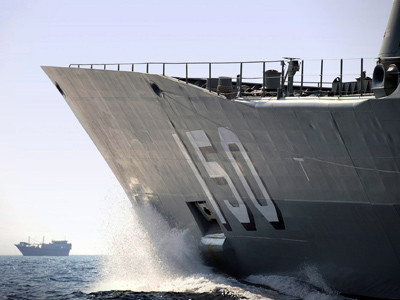Maritime Platform Performance

The Maritime Platform Performance (MPP) branch within Maritime Division aims to ensure the Royal Australian Navy Fleet has platforms that are safe, efficient, sustainable, survivable and seaworthy for their desired operational envelope.
This aim is achieved through quantitative analyses, modelling and simulation, which are underpinned and validated by experimental programs. These programs provide science and technology solutions for the safety, sustainability, survivability and seaworthiness of maritime platforms for current and future operations.
The MPP capabilities encompasses i) platform and material structural integrity prediction and assessment, (ii) vulnerability, recoverability and survivability assessment of platforms and systems from combat and non-combat threats, (iii) naval architecture (iv) power and energy system modelling and integration, and (v) platform concepts and requirements analysis. These capabilities support the platform performance capability and mission survivability of maritime operations.
The infrastructure of the branch has been strategically planned and includes shared facilities such as the Australian National Hydrodynamics Research Centre at the University of Tasmania (Australian Maritime College). The branch also has strong strategic partnerships with both Australian and international universities and allied government defence laboratories. These partnerships are used to support:
- decisions related to the prediction of structural integrity and performance.
- decisions on performance and power and energy requirements of ships and submarines.
- assessment of the vulnerability of platforms and systems from combat and non-combat threats.
- assessment and optimisation of the recoverability of a platform from damage.assessment of options and trade-offs of maritime platforms for mission survivability.
Australian Navy Fleet
MPP has been instrumental in the sustainment of the Armidale Class Patrol Boats, Collins Class Submarines, and ANZAC Class Ships. This MSTC is integral to providing high-quality advice and assessment options for Australian navy fleet acquisition projects such as the future frigates, future submarines and the offshore patrol vessels.
The outcomes of this MSTC include (i) improved availability, safety and survivability of ships and submarines, and (ii) improved platform performance requirements for future acquisitions. MPP also assists the Navy's delivery of the Strategic Reform program and provides support to the national shipbuilding strategy.
Naval Architecture and Platform System Analysis
The Naval Architecture and Platform System Analysis group develops enhanced analysis techniques and provides the scientific analysis to assess platform characteristics and performance against defined requirements.
The group conducts naval architectural assessments, system analysis and capability trade-off assessments and optimisation for existing and proposed ships, submarines and the integration of unmanned vehicles.
Power and Energy systems
The Power and Energy Systems group undertakes development, assessment, modelling, simulation, prediction and/or advanced control of maritime energy generation, storage and distribution systems for the ADF, addressing battery performance and charging, new battery technologies, power management and control.
This includes modelling, analysis and experimentation into propulsion technologies including diesel engine operation, electric propulsion, control systems and reliability.
Materials Performance and Structural Integrity
The Materials Performance and Structural Integrity group encompasses the development and evaluation of maritime materials systems and structural integrity assessment tools to ensure through-life structural integrity and minimise the platform vulnerability of the current and future RAN fleet. The group utilises computational modelling and simulation and other predictive techniques in support of this role.
The group is primarily focussed on (i) the performance of metallic material systems for their intended operating environment, (ii) the effects of materials processes and fabrication techniques on the performance of metallic materials, and (iii) submarine structural analysis for different types of failure (ie collapse, fatigue, grounding and collision).
Dynamic Military Loads
The Dynamic Military Loads group assesses the performance of maritime platforms and systems against shock wave and other dynamic loading events typically from underwater weapons.
The technologies in this area are used to (i) assess the vulnerability of platforms against these threats in terms of the loads that cause structural, equipment and human vulnerability damage, (ii) develop modelling and simulation methods to enhance the operational vulnerability capability of maritime platforms, (iii) develop shock specifications and testing standards for maritime platforms and systems and (iv) develop measurement, assessment and analysis methods for rapid loading events.
Naval Platform Survivability
The Naval Platform Survivability group encompasses the modelling, analysis and experimentation of vulnerability, damage control and recoverability of maritime platforms against various combat and non -combat threats and incidents to aid in platform design options and improve safety.
The group analyses the vulnerability, damage and system failure from events including ballistic, blast, fire, smoke and hazardous atmospheres.
The analysis of damage control technologies and fire protection systems are used to develop damage control and recoverability strategies, human system response and human factors aspects of damage control. The group also assesses and provides advice on atmosphere habitability technologies and strategies to support crew safety and platform endurance.
Integrated survivability modelling incorporates vulnerability, damage control and recoverability models to assess survivability of maritime platforms. It includes the development of modelling architectures for communication between these survivability models.

